Serina Chang
Language Model Fine-Tuning on Scaled Survey Data for Predicting Distributions of Public Opinions
Feb 24, 2025Abstract:Large language models (LLMs) present novel opportunities in public opinion research by predicting survey responses in advance during the early stages of survey design. Prior methods steer LLMs via descriptions of subpopulations as LLMs' input prompt, yet such prompt engineering approaches have struggled to faithfully predict the distribution of survey responses from human subjects. In this work, we propose directly fine-tuning LLMs to predict response distributions by leveraging unique structural characteristics of survey data. To enable fine-tuning, we curate SubPOP, a significantly scaled dataset of 3,362 questions and 70K subpopulation-response pairs from well-established public opinion surveys. We show that fine-tuning on SubPOP greatly improves the match between LLM predictions and human responses across various subpopulations, reducing the LLM-human gap by up to 46% compared to baselines, and achieves strong generalization to unseen surveys and subpopulations. Our findings highlight the potential of survey-based fine-tuning to improve opinion prediction for diverse, real-world subpopulations and therefore enable more efficient survey designs. Our code is available at https://github.com/JosephJeesungSuh/subpop.
LLMs generate structurally realistic social networks but overestimate political homophily
Aug 29, 2024
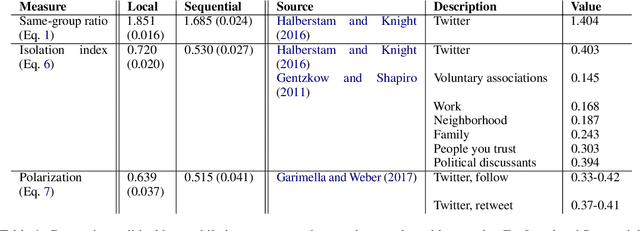
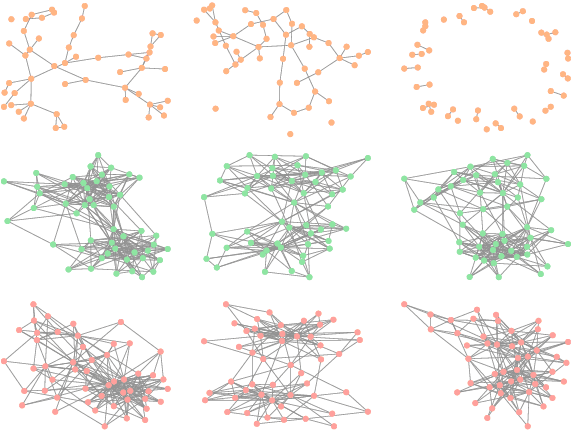

Abstract:Generating social networks is essential for many applications, such as epidemic modeling and social simulations. Prior approaches either involve deep learning models, which require many observed networks for training, or stylized models, which are limited in their realism and flexibility. In contrast, LLMs offer the potential for zero-shot and flexible network generation. However, two key questions are: (1) are LLM's generated networks realistic, and (2) what are risks of bias, given the importance of demographics in forming social ties? To answer these questions, we develop three prompting methods for network generation and compare the generated networks to real social networks. We find that more realistic networks are generated with "local" methods, where the LLM constructs relations for one persona at a time, compared to "global" methods that construct the entire network at once. We also find that the generated networks match real networks on many characteristics, including density, clustering, community structure, and degree. However, we find that LLMs emphasize political homophily over all other types of homophily and overestimate political homophily relative to real-world measures.
Learning production functions for supply chains with graph neural networks
Jul 26, 2024Abstract:The global economy relies on the flow of goods over supply chain networks, with nodes as firms and edges as transactions between firms. While we may observe these external transactions, they are governed by unseen production functions, which determine how firms internally transform the input products they receive into output products that they sell. In this setting, it can be extremely valuable to infer these production functions, to better understand and improve supply chains, and to forecast future transactions more accurately. However, existing graph neural networks (GNNs) cannot capture these hidden relationships between nodes' inputs and outputs. Here, we introduce a new class of models for this setting, by combining temporal GNNs with a novel inventory module, which learns production functions via attention weights and a special loss function. We evaluate our models extensively on real supply chains data, along with data generated from our new open-source simulator, SupplySim. Our models successfully infer production functions, with a 6-50% improvement over baselines, and forecast future transactions on real and synthetic data, outperforming baselines by 11-62%.
Inferring Dynamic Networks from Marginals with Iterative Proportional Fitting
Feb 28, 2024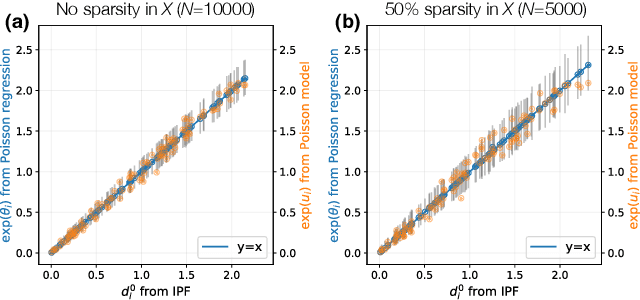
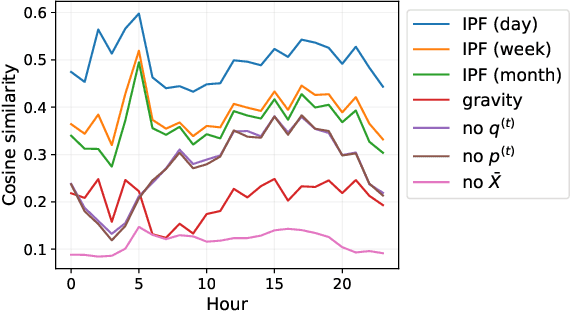

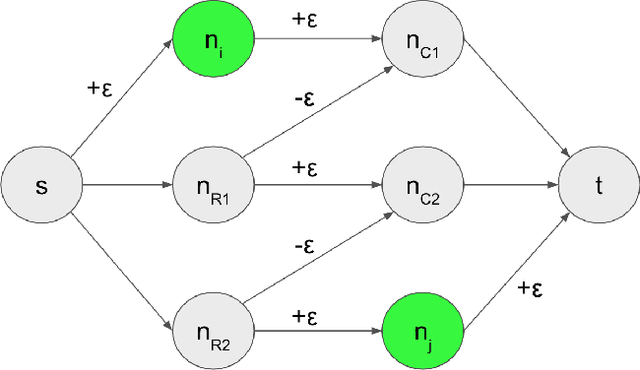
Abstract:A common network inference problem, arising from real-world data constraints, is how to infer a dynamic network from its time-aggregated adjacency matrix and time-varying marginals (i.e., row and column sums). Prior approaches to this problem have repurposed the classic iterative proportional fitting (IPF) procedure, also known as Sinkhorn's algorithm, with promising empirical results. However, the statistical foundation for using IPF has not been well understood: under what settings does IPF provide principled estimation of a dynamic network from its marginals, and how well does it estimate the network? In this work, we establish such a setting, by identifying a generative network model whose maximum likelihood estimates are recovered by IPF. Our model both reveals implicit assumptions on the use of IPF in such settings and enables new analyses, such as structure-dependent error bounds on IPF's parameter estimates. When IPF fails to converge on sparse network data, we introduce a principled algorithm that guarantees IPF converges under minimal changes to the network structure. Finally, we conduct experiments with synthetic and real-world data, which demonstrate the practical value of our theoretical and algorithmic contributions.
Machine Learning for Health symposium 2023 -- Findings track
Dec 01, 2023Abstract:A collection of the accepted Findings papers that were presented at the 3rd Machine Learning for Health symposium (ML4H 2023), which was held on December 10, 2023, in New Orleans, Louisiana, USA. ML4H 2023 invited high-quality submissions on relevant problems in a variety of health-related disciplines including healthcare, biomedicine, and public health. Two submission tracks were offered: the archival Proceedings track, and the non-archival Findings track. Proceedings were targeted at mature work with strong technical sophistication and a high impact to health. The Findings track looked for new ideas that could spark insightful discussion, serve as valuable resources for the community, or could enable new collaborations. Submissions to the Proceedings track, if not accepted, were automatically considered for the Findings track. All the manuscripts submitted to ML4H Symposium underwent a double-blind peer-review process.
Accurate Measures of Vaccination and Concerns of Vaccine Holdouts from Web Search Logs
Jun 12, 2023Abstract:To design effective vaccine policies, policymakers need detailed data about who has been vaccinated, who is holding out, and why. However, existing data in the US are insufficient: reported vaccination rates are often delayed or missing, and surveys of vaccine hesitancy are limited by high-level questions and self-report biases. Here, we show how large-scale search engine logs and machine learning can be leveraged to fill these gaps and provide novel insights about vaccine intentions and behaviors. First, we develop a vaccine intent classifier that can accurately detect when a user is seeking the COVID-19 vaccine on search. Our classifier demonstrates strong agreement with CDC vaccination rates, with correlations above 0.86, and estimates vaccine intent rates to the level of ZIP codes in real time, allowing us to pinpoint more granular trends in vaccine seeking across regions, demographics, and time. To investigate vaccine hesitancy, we use our classifier to identify two groups, vaccine early adopters and vaccine holdouts. We find that holdouts, compared to early adopters matched on covariates, are 69% more likely to click on untrusted news sites. Furthermore, we organize 25,000 vaccine-related URLs into a hierarchical ontology of vaccine concerns, and we find that holdouts are far more concerned about vaccine requirements, vaccine development and approval, and vaccine myths, and even within holdouts, concerns vary significantly across demographic groups. Finally, we explore the temporal dynamics of vaccine concerns and vaccine seeking, and find that key indicators emerge when individuals convert from holding out to preparing to accept the vaccine.
Automatically Inferring Gender Associations from Language
Aug 30, 2019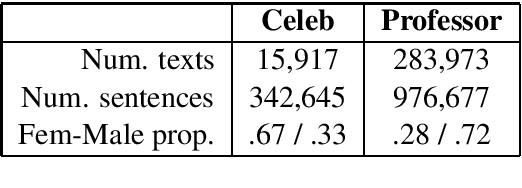
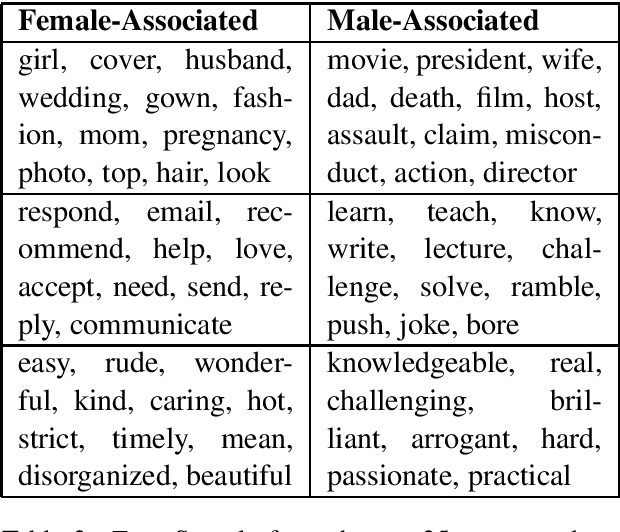

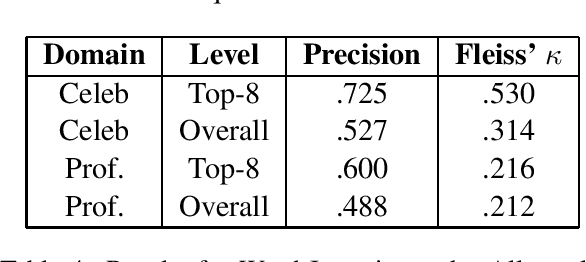
Abstract:In this paper, we pose the question: do people talk about women and men in different ways? We introduce two datasets and a novel integration of approaches for automatically inferring gender associations from language, discovering coherent word clusters, and labeling the clusters for the semantic concepts they represent. The datasets allow us to compare how people write about women and men in two different settings - one set draws from celebrity news and the other from student reviews of computer science professors. We demonstrate that there are large-scale differences in the ways that people talk about women and men and that these differences vary across domains. Human evaluations show that our methods significantly outperform strong baselines.
Detecting Gang-Involved Escalation on Social Media Using Context
Sep 10, 2018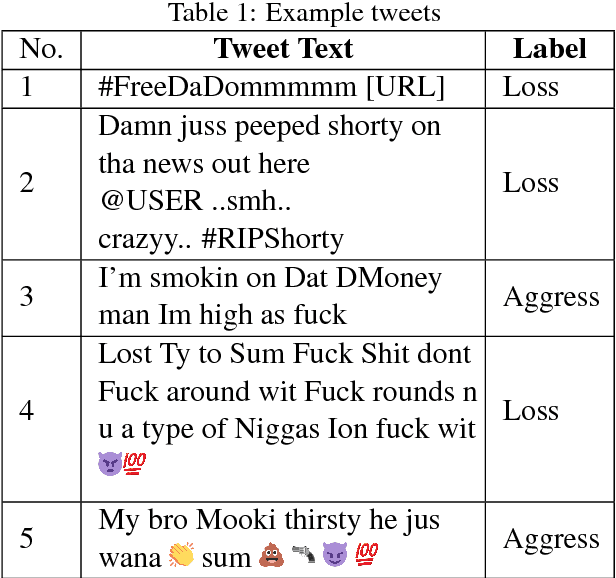
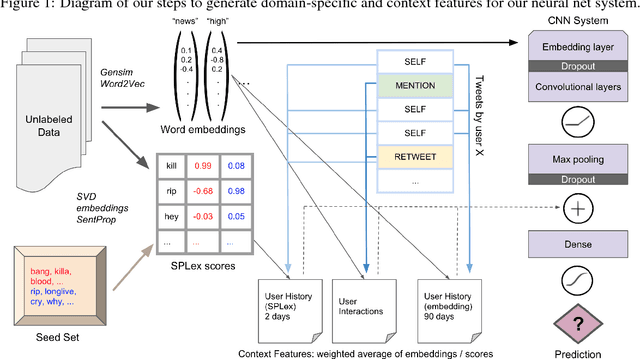
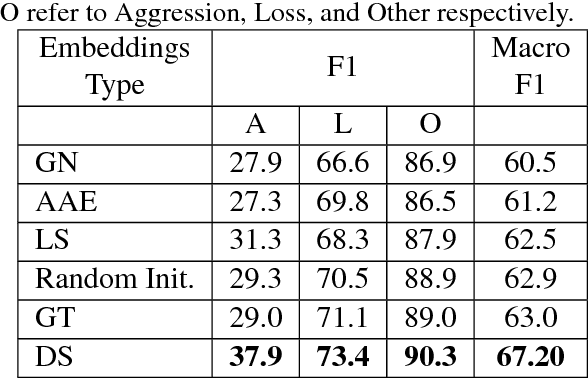

Abstract:Gang-involved youth in cities such as Chicago have increasingly turned to social media to post about their experiences and intents online. In some situations, when they experience the loss of a loved one, their online expression of emotion may evolve into aggression towards rival gangs and ultimately into real-world violence. In this paper, we present a novel system for detecting Aggression and Loss in social media. Our system features the use of domain-specific resources automatically derived from a large unlabeled corpus, and contextual representations of the emotional and semantic content of the user's recent tweets as well as their interactions with other users. Incorporating context in our Convolutional Neural Network (CNN) leads to a significant improvement.
* 12 pages
 Add to Chrome
Add to Chrome Add to Firefox
Add to Firefox Add to Edge
Add to Edge